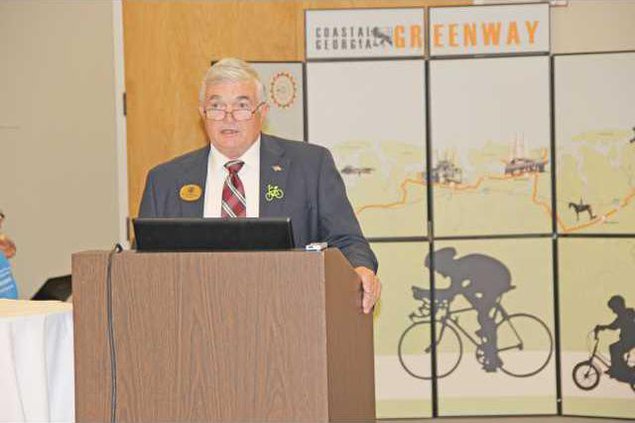RICHMOND HILL — Supporters of the proposed Coastal Georgia Greenway touted its economic potential and health and safety benefits to a joint study committee that met Monday.
The 13-member committee, which includes four state senators and four state House representatives, will decide what recommendations — if any — to make to state legislators regarding the possible Coastal Georgia Greenway, a 155-mile paved trail connecting six coastal counties that has been discussed for nearly two decades.
Bryan County Commissioner and greenway supporter Rick Gardner urged the joint House and Senate committee to ask Gov. Nathan Deal to include money for the project in the state’s next fiscal-year budget. Other revenue sources could include grants, sponsorships and public-private partnerships, Gardner said.
The committee gathered for the first time Monday at the City Center. An endorsement from the group would help Coastal Georgia Greenway supporters toward their goal of constructing the trail in five phases over the next five years.
“We’d like to celebrate in 2021,” Gardner said. “It’s time now for the state legislators to help link those communities with safe trails.”
The greenway would run through Chatham, Bryan, Liberty, McIntosh, Glynn and Camden counties. The six counties and nine cities along the trail all support the project, according to Jo Hickson of the nonprofit organization Coastal Georgia Greenway Inc.
“All of the local jurisdictions have adopted the Coastal Georgia Greenway route,” Hickson said. “We do have resolutions from each of the
15 local jurisdictions in support of the proposal.”
Supporters envision the greenway providing educational, recreational and tourism opportunities throughout the six coastal counties. The trail would link more than 115,000 acres of existing wildlife preserves, parks and historic districts.
“The greenway will provide a new destination activity, long-distance cycling, that will enhance visitation,” Gardner said. “Cycling also feeds the local economy. Existing businesses, restaurants, inns and retail stores benefit from the increased traffic, and locals can bike from home or work.”
To support Gardner’s point, Armstrong State University economics professor Michael Toma presented his study of the greenway’s potential usage and economic impact. He analyzed data from other states’ bicycle trails as part of his research.
The Coastal Georgia Greenway could have approximately 220,000 users in its first year and nearly 500,000 five years later, Toma estimated. That would generate about $5 million in state and local tax revenue and increase property values along the trail “roughly 3 to 6 percentage points,” he said.
“I think this will be a very attractive economic development and tourism attribute,” Toma said.
One of the supporters in attendance, John Cameron, agreed. Cameron co-owns Game Changers Bike and Multi-Sport in Richmond Hill and is an advocate of community bike trails.
“Georgia is losing bicycle tourism to Florida and the Carolinas,” Cameron said. “We have so much to gain as a community with the Coastal Georgia Greenway.”
Gardner also pointed to the health benefits of the greenway. He said obesity is at “epidemic levels,” citing figures that Georgia has the 14th-highest rate of adult obesity in the nation and third-highest rate of overweight children ages 10-17.
In addition, Gardner told the committee, the greenway would provide a safe route for bicyclists to traverse.
He shared the story of Joseph Bramlett, 62, who died June 21 in Brunswick when his bicycle collided with an SUV on Highway 17. The fatal crash occurred in a 0.7-mile gap in the concrete bicycle path along the highway, according to published reports.
State Rep. Bill Hitchens, R-Rincon, one of the study committee members, asked how much of the proposed trail already is in place. Hickson answered that approximately 24 percent is either existing or planned for construction.

